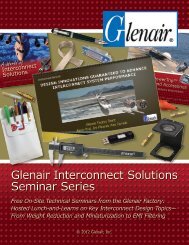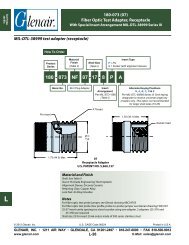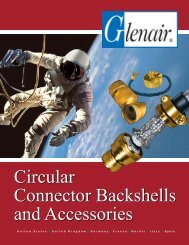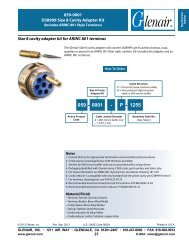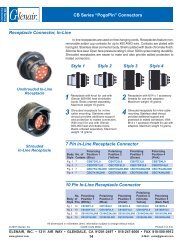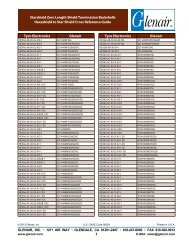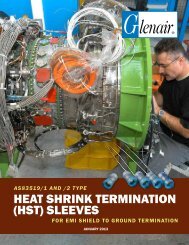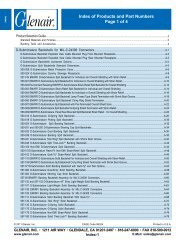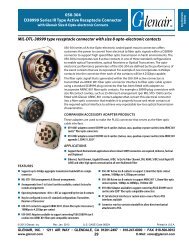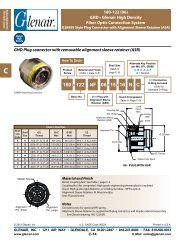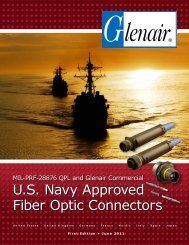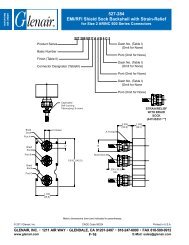EMI/EMP Filter Connectors Catalog - Glenair, Inc.
EMI/EMP Filter Connectors Catalog - Glenair, Inc.
EMI/EMP Filter Connectors Catalog - Glenair, Inc.
- No tags were found...
Create successful ePaper yourself
Turn your PDF publications into a flip-book with our unique Google optimized e-Paper software.
Introduction to <strong>Filter</strong> <strong>Connectors</strong><strong>EMI</strong> <strong>Filter</strong>s and Transient Voltage Suppression PackagingIntroduction<strong>EMI</strong> <strong>Filter</strong> and TransientVoltage Suppression PackagingAThe packaging of <strong>EMI</strong> and TVS elementsin standard connectors is an importantelement in effective EMC design. <strong>EMI</strong>/<strong>EMP</strong>connectors typically come in Mil-Spec packagingfor easy intermating with Mil-Spec circular,D-sub, Micro-D and other standard formats. Suchconnectors are broadly identified as ‘low-pass’filters (i.e., they let low frequencysignals pass through andattenuate higher frequencies).The attenuation curve canbe shaped using differentfilter types (differentconfigurations ofcapacitors and inductors).While the exteriorof these very specialconnectors look normalenough, inside is anotherstory—a planar array madeof multiple layers of ceramicdielectric, separated by sheets ofceramic tape and screen printed with a patternof metal electrodes to create a capacitor usedto suppress or attenuate unwanted noise.Capacitance at each electrode protects against<strong>EMI</strong>, while carefully placed transient voltagesuppression diodes guard against damage fromlightning strike and other voltage surges.Planar, multi-layer ceramic capacitive filtersoffer reduced size and improved performancecompared to discrete discoidal chips or tubularcapacitors. Planar array filter devices havethe advantage, especially when comparedto capacitive filters integrated at the circuitboard level, of being bidirectionally effective atattenuating unwanted noise travelling into and outof equipment enclosures.As critical <strong>EMI</strong> problems are often discoveredlate in the development process—perhaps onlyafter equipment has been installed for use—itis critical that turnaround times in design andfabrication of both standard and non-standarddesigns are kept to a minimum. <strong>Glenair</strong> iscommitted to meeting the most aggressivedelivery requirements for planar array type filterconnectors.<strong>Glenair</strong>’s Growing <strong>Filter</strong>Connector AvailabilityApplications requiring filteredconnectors generally call forspecific plating, mounting style,keying, shell size, contact layout,contact gender, termination, andfrequency filtration. Typically, thefiltered connector is either replacingan existing non-filtered receptacle,or it must mate with an existing cableplug. In some cases the filtering element is builtinto a connector go-between or saver. Whateverthe packaging requirement, <strong>Glenair</strong> is committedto a “no gaps” product availability model wherebywe can quickly build and ship any possible filterconnector configuration for industry standardconnector families such as MIL-DTL-38999,MIL-DTL-83513 and our own Series 80 “MightyMouse.”Shell SizeandContact CountCapacitanceCodes9 A, B, D, F15 A, D21 A, C, D25 B, D, F31 D37 B, D, F© 2008 <strong>Glenair</strong>, <strong>Inc</strong>. CAGE Codes 06324Printed in U.S.A.GLENAIR, INC. • 1211 AIR WAY • GLENDALE, CA 91201-2497 • 818-247-6000 • FAX 818-500-9912www.glenair.comA-11E-Mail: sales@glenair.com




